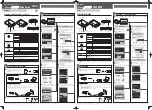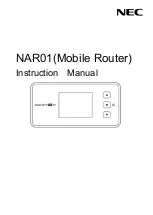
Installing the Access Point
57
•
Temperature —
The OAP433e is tested for normal operation in temperatures from - 40°F
to 140°F. Operating in temperatures outside of this range may cause the unit to fail.
•
Wind Velocity —
The OAP433e can operate in winds up to 44 m/s and survive higher wind
speeds up to 66 m/s. You must consider the known maximum wind velocity and direction at
the site and be sure that any supporting structure, such as a pole, mast, or tower, is built to
withstand this force.
•
Lightning —
You should make sure that the unit, any supporting structure, and cables are
all properly grounded. Additional protection using lightning rods, lightning arrestors, or
surge suppressors may also be employed in order to protect against lightning strikes on the
antennas. Contact Fortinet Sales for more information regarding this equipment.
•
Rain
— The OAP433e is weatherproofed against rain. Also, prolonged heavy rain has no
significant effect on the radio signal. However, it is recommended to apply weatherproof
sealing tape around the Ethernet port and antenna connectors for extra protection. If mois-
ture enters a connector, it may cause a degradation in performance or even a complete fail-
ure of the link.
•
Snow and Ice —
Falling snow, like rain, has no significant effect on the radio signal. How-
ever, a build up of snow or ice on antennas may cause the link to fail. In this case, the snow
or ice has to be cleared from the antennas to restore operation of the link.
Ethernet Cabling
When a suitable antenna location has been determined, plan a cable route from the OAP433e
outdoors to the PoE-enabled controller indoors. Consider these points:
•
The Ethernet cable length should never be longer than 100 ft.
•
Determine a building entry point for the cable.
•
Determine if conduits, bracing, or other structures are required for safety or protection of
the cable.
•
For lightning protection at the controller end of the cable, consider using a lightning arrestor
immediately before the cable enters the building.
•
The shield of the ethernet cable needs to be grounded at the lightning arrestor. If, by
design, the lightning arrestor cannot provide this ground, the shield of the ethernet cable
will need to be grounded by the installer.
Grounding
It is important that the OAP433e, cables, and any supporting structures are properly
grounded. The OAP433e unit includes a grounding screw to attach a ground wire. (See
for grounding screw locations.) Be sure that grounding is available and
that it meets local and national electrical codes.
Summary of Contents for AP400 Series
Page 26: ...Table of Contents xii...
Page 30: ...Contacting Fortinet 16...
Page 33: ...AP400 19 Figure 2 AP433e Figure 3 AP433i is RESET CONSOLE G1 USB 00258 00275...
Page 34: ...AP400 20 Figure 4 OAP433e Outdoor Access Point top and bottom...
Page 52: ...Where to Go From Here 38...
Page 66: ...Where to Go From Here 52...
Page 80: ...Where to Go From Here 66...
Page 86: ...Warnings 72...
Page 98: ...Manufacturing Information 84...
Page 100: ...Supported Power Over Ethernet Devices for Fortinet APs 86...
Page 102: ...88...
















































